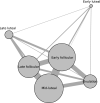The Effects of Menstrual Cycle Phase on Exercise Performance in Eumenorrheic Women: A Systematic Review and Meta-Analysis
- PMID: 32661839
- PMCID: PMC7497427
- DOI: 10.1007/s40279-020-01319-3
The Effects of Menstrual Cycle Phase on Exercise Performance in Eumenorrheic Women: A Systematic Review and Meta-Analysis
Abstract
Background: Concentrations of endogenous sex hormones fluctuate across the menstrual cycle (MC), which could have implications for exercise performance in women. At present, data are conflicting, with no consensus on whether exercise performance is affected by MC phase.
Objective: To determine the effects of the MC on exercise performance and provide evidence-based, practical, performance recommendations to eumenorrheic women.
Methods: This review followed the Preferred Reporting Items for Systematic Reviews and Meta-Analyses (PRISMA) guidelines. Four databases were searched for published experimental studies that investigated the effects of the MC on exercise performance, which included at least one outcome measure taken in two or more defined MC phases. All data were meta-analysed using multilevel models grounded in Bayesian principles. The initial meta-analysis pooled pairwise effect sizes comparing exercise performance during the early follicular phase with all other phases (late follicular, ovulation, early luteal, mid-luteal and late luteal) amalgamated. A more comprehensive analysis was then conducted, comparing exercise performance between all phases with direct and indirect pairwise effect sizes through a network meta-analysis. Results from the network meta-analysis were summarised by calculating the Surface Under the Cumulative Ranking curve (SUCRA). Study quality was assessed using a modified Downs and Black checklist and a strategy based on the recommendations of the Grading of Recommendations Assessment Development and Evaluation (GRADE) working group.
Results: Of the 78 included studies, data from 51 studies were eligible for inclusion in the initial pairwise meta-analysis. The three-level hierarchical model indicated a trivial effect for both endurance- and strength-based outcomes, with reduced exercise performance observed in the early follicular phase of the MC, based on the median pooled effect size (ES0.5 = - 0.06 [95% credible interval (CrI): - 0.16 to 0.04]). Seventy-three studies had enough data to be included in the network meta-analysis. The largest effect was identified between the early follicular and the late follicular phases of the MC (ES0.5 = - 0.14 [95% CrI: - 0.26 to - 0.03]). The lowest SUCRA value, which represents the likelihood that exercise performance is poor, or among the poorest, relative to other MC phases, was obtained for the early follicular phase (30%), with values for all other phases ranging between 53 and 55%. The quality of evidence for this review was classified as "low" (42%).
Conclusion: The results from this systematic review and meta-analysis indicate that exercise performance might be trivially reduced during the early follicular phase of the MC, compared to all other phases. Due to the trivial effect size, the large between-study variation and the number of poor-quality studies included in this review, general guidelines on exercise performance across the MC cannot be formed; rather, it is recommended that a personalised approach should be taken based on each individual's response to exercise performance across the MC.
Conflict of interest statement
Kelly Lee McNulty, Kirsty Jayne Elliott-Sale, Eimear Dolan, Paul Alan Swinton, Paul Ansdell, Stuart Goodall, Kevin Thomas and Kirsty Marie Hicks declare that they have no potential conflicts of interest with the content of this article.
Figures





Comment in
-
Reply to: Comment on: "The Effects of Menstrual Cycle Phase on Exercise Performance in Eumenorrheic Women: A Systematic Review and Meta-Analysis" and "The Effects of Oral Contraceptives on Exercise Performance in Women: A Systematic Review and Meta-analysis".Sports Med. 2021 May;51(5):1111-1113. doi: 10.1007/s40279-020-01383-9. Sports Med. 2021. PMID: 33332009 No abstract available.
-
Comment on: "The Effects of Menstrual Cycle Phase on Exercise Performance in Eumenorrheic Women: A Systematic Review and Meta-Analysis" and "The Effects of Oral Contraceptives on Exercise Performance in Women: A Systematic Review and Meta-analysis".Sports Med. 2021 May;51(5):1107-1109. doi: 10.1007/s40279-020-01384-8. Epub 2020 Dec 17. Sports Med. 2021. PMID: 33332010 No abstract available.
References
-
- European Commission. Gender equality in sport: proposal for strategic actions 2014–2020. https://ec.europa.eu/sport/news/2014/gender_equality_sporten. Accessed 3 Dec 2019.
-
- International Working Group on Women and Sport, Women Sport International. Women, gender equality and sport. New York (NY), 2007. http://www.un.org/womenwatch/daw/public/Women%20and%20Sport.pdf. Accessed 3 Dec 2019.
-
- Fink JS. Female athletes, women’s sport, and the sport media commercial complex: have we really “come a long way, baby”? Sport Manage. Rev. 2015;18(3):331–342. doi: 10.1016/j.smr.2014.05.001. - DOI
-
- Forsyth J, Roberts CM. Introduction to the exercising female: science and its application. In: Forsyth J, Roberts CM, editors. the exercising female. London: Routledge; 2018. pp. 1–6.
-
- The International Olympic Committee. Promotion of women in sport through time. https://www.olympic.org/women-in-sport/background. Accessed 3 Dec 2019.
Publication types
MeSH terms
LinkOut - more resources
Full Text Sources
Medical

